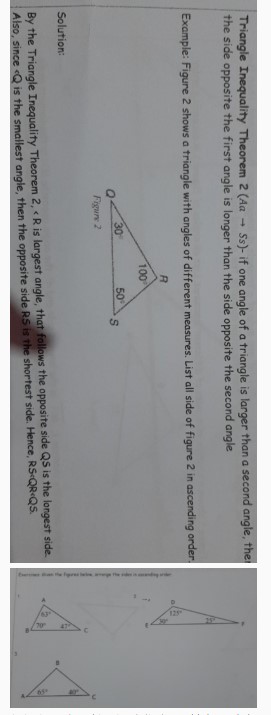QQuestionAnatomy and Physiology
QuestionAnatomy and Physiology
Triangle Inequality Theorem 2 (Aa → Ss) - if one angle of a triangle is larger than a second angle, then the side opposite the first angle is longer than the side opposite the second angle.
Example: Figure 2 shows a triangle with angles of different measures. List all sides of Figure 2 in ascending order.
Solution:
By the Triangle Inequality Theorem 2, *R* is a largest angle, that follows the opposite side QS is the longest side. Also, since *Q* is the smallest angle, then the opposite side *R* is the shortest side. Hence, *R*S-QR-QS.
Attachments

6 months agoReport content
Answer
Full Solution Locked
Sign in to view the complete step-by-step solution and unlock all study resources.
Step 1: Identify the longest side of the triangle.
QS\text{ is the longest side.}
By the Triangle Inequality Theorem 2 (Aa → Ss), if one angle of a triangle is larger than a second angle, then the side opposite the first angle is longer than the side opposite the second angle.
Step 2: Identify the shortest side of the triangle.
RS\text{ is the shortest side.}
Again, using the same theorem, if an angle is the smallest angle in a triangle, then the side opposite that angle is the shortest side.
Final Answer
The sides of the triangle in ascending order are $RS$, $QR$, and $QS$.
Need Help with Homework?
Stuck on a difficult problem? We've got you covered:
- Post your question or upload an image
- Get instant step-by-step solutions
- Learn from our AI and community of students